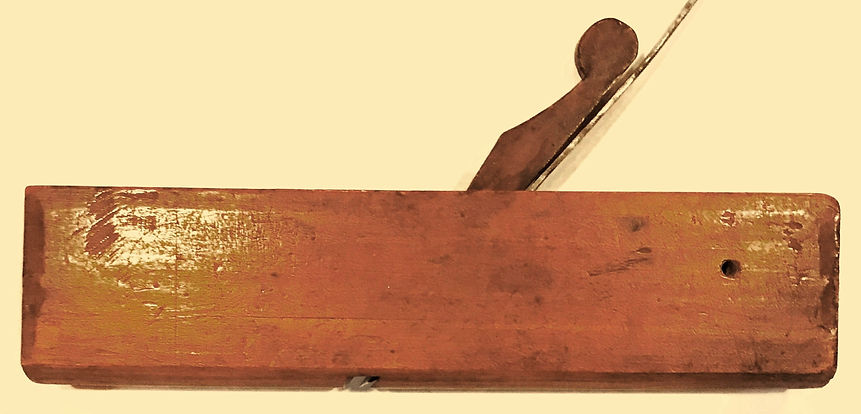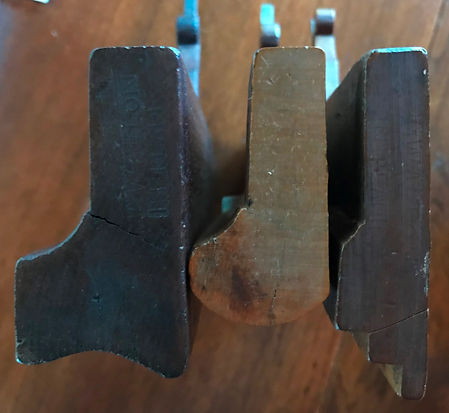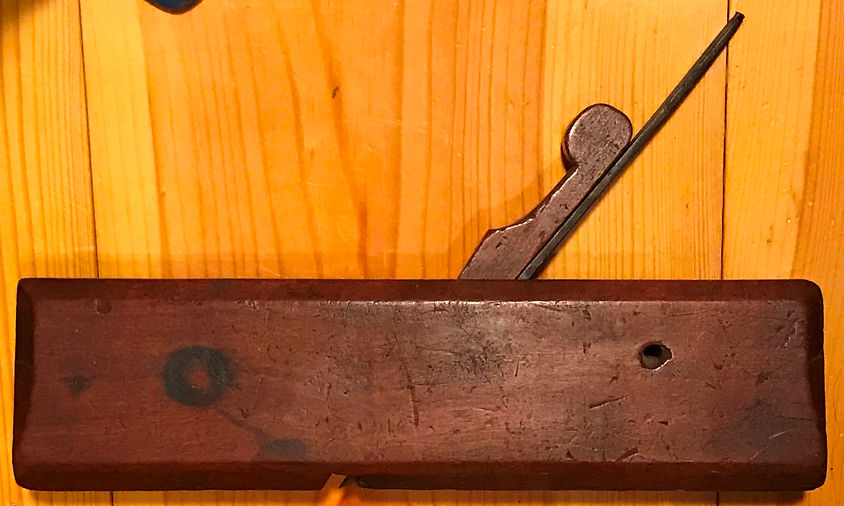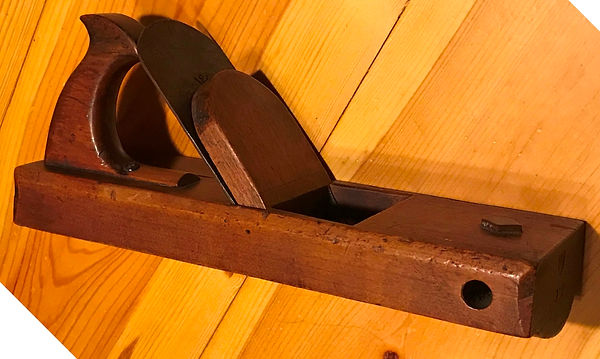John Walton Jr. Planes
(revised 8-9-2023 and 5-29-2025)
John Walton Jr. (1710-1785)
Reading, MA joiner and housewright

(Note the corrected birth year of 1710.)

Editor's note 8-9-2023. Periodically, plane enthusiasts pose a question or forward an observation and in the process, challenge each other in their understandings and assumptions. This happened recently with the editor and Dave S. and Mike H. resulting in a re-consideration of the plane detail (date) sequence observed in I Walton planes. The following assessment is not necessarily held by all members of the said discussion and therefore should be considered a work-in-progress.
For this reassessment, I Walton planes in a least 5 collections have been studied. While only a limited number of planes have been studied so far (approximately 20), the planes seem to break out into three distinct groups (earlier, middle and later). The planes in each group are relatively consistent with respect to one another and the traits of each group seem to be distinctive.
That being said, it is fully anticipated that planes with blended traits will be found as more planes are assessed and that information will be added to this presentation. In fact, as this material was being proofed, an early/middle "transitional" plane has been reported by Mike H. This plane is described as having an intermediate shaped wedge cut-out and an intermediate chamfer body angle.
Thanks to Dave S, Mike H, Steve F and Tom E for sharing their collections and knowledge, as well as their posing questions/challenges in our back and forth discussions. (This is always the best part of researching as well as collecting.)
The following, is a reorganization of the previously assembled material into a new timeline.
Earlier Plane Details (A mark) (new material)
main traits:
Small wedge finial (approximately 0.7" high by 0.8" deep) and the cut-outs under the finial have a shallow curvature.
The body chamfers are very shallow ... approximately 10 degrees.
secondary traits:
The body chamfers end with a tipped line, a slight raised bump-out, followed by a faint flute having slight curvature. The flutes are often crude and uneven, showing variations between the toe and heel. One plane has been reported with chamfer ends similar to the middle group.
Most planes have heels with a tight curve, but one has been reported that has a larger radius.
Middle Plane Details (A mark) (new material)
main traits:
Slightly larger finial somewhat oval in shape (approximately 0.75" high by 0.95" deep) and the cut-outs under the finial show a greater curvature.
The body chamfers have a greater angle ... approximately 25 degrees.
secondary traits:
The body chamfers end with a tipped line followed by long tapered return. These chamfer ends seem to be better made and more consistent.
Most planes have heels with a tight curve, but one has been reported that has a larger radius.
Later Plane Details (A mark) (as previously reported)
main traits:
Same wedge design as the middle group.
Body chamfer angle matches the middle group.
Chamfer stops are defined by a bold step followed by a short turn-out.
secondary traits:
Heels with a larger curve radius
I Walton molders have lengths that are typically 10 1/8 to 10 3/16". A few of his molders are 10" but there doesn't seem to be a pattern between the plane details and the shorter length.
IW Planes (B mark) planes are now being proposed by the editor, (5-2025), as possibly being John III's first planes
Three planes were reviewed, an IW crown molder, a double stamped IW / I Walton molder, and an IW molder.
Based on three planes (the double stamped plane being made by John Jr.):
Same wedge finial as middle A group molding planes, with wedge cut-outs having slightly more curvature.
Body chamfer angle matches the middle A group.
Chamfer stops match the middle A group planes.
Tight curvature to heels.
A imprint, I Walton / In Reading
Earlier Plane Details





A imprint, Earlier Detail planes have the shallow body chamfers with a generally crude, fluted-like chamfer stop design: a tipped step followed by a raised return and a lower continuous flute. (They are variable and less defined than the similar elements found on F Nicholson planes as well as those of early H Wetherel, early Ce Chelor, I Gould and E Clark, among others from 18th C SE Massachusetts).




A imprint, Earlier Detail planes have wedges with small finials and shallow cut-outs under the finial.

Plow plane; A imprint, earlier period chamfer stops. (replaced wedge.) (See similarities with N Potter.)


Crown molder; A imprint, earlier period chamfer stops. (See similarities with T Evans.)

A imprint, I Walton / In Reading
Middle Detail Planes


A imprint, Middle Detail planes have the steeper body chamfers (roughly 25 degrees). The chamfers end with a tipped step followed by a long tapered return. These are more consistent and better made than the earlier flutes.


Detail of the middle chamfer stop design: a faint tipped step followed by a long straight tapered cut. Minimal to no bump-out is present between the tipped step and the long taper chamfer.

A imprint, Middle Detail planes have wedges with slightly larger finials that tend towards oval and cut-outs that have a greater curvature under the finial.

A imprint, I Walton / In Reading
Transitional Earlier / Middle Plane
The body chamfers have a transitional angle, between "shallow" and "steeper". The wedge finial is more of the middle form whereas the cutout is transitional, between a shallow and a greater curvature form. The chamfer stop ends with a detail that is more of a flute than a long taper. The plane is 10 5/32" long.

Wedges; early, middle, transitional presented top to bottom. On the transitional wedge, the finial is more of the middle form whereas the cutout is transitional, between a shallow and a greater curvature form.

A imprint, I Walton / In Reading
Later Detail Planes
Examples of the A imprint with "later" period chamfer stops; a straight step followed by a simple turn out cut. The body chamfers match the higher angle of the middle phase planes. The "later" chamfer stops on John Walton Jr planes, match those found on planes made by his sons Benjamin and John III, giving them an approximate date of 1765 to 1770. The wedges are similar to those found on the middle phase planes (varying slightly with a greater cutout curvature) and match those found on the planes made by his sons. This amended sequence makes "sense", in that the late phase planes have similarities (wedges and body chamfer angles) to those found on the middle phase planes. (In the previous sequence they were closer to the "earlier" planes.) A suggestion has been forwarded that perhaps John III made some of these later I Walton planes ... a position which is entirely plausible.
Note, a final form of late chamfer stop might be seen on a cherry plow marked B Walton / In Reading. Here the body chamfers simply turn out without a step in between.



Additional details and planes
Period ink price found on the heel of a A mark crown molder.

IW Planes (B mark) are being proposed by the editor, (5-2025), as possibly being John III's first planes
Three planes were reviewed, an IW crown molder, a double stamped IW / I Walton molder (which was made by John Jr.), and an IW molder.
Admittedly, this new proposal regarding the B imprint might be considered counter intuitive as the IW planes had been theorized as John Walton Jr's first planes. The double stamped molding plane is being presented as the reason to revise this attribution.
The IW planes are being proposed as having been made by John III during the time frame his father John Jr. was making his middle "period" planes, based on the common chamfer stops and wedge finial details. A similar parallel situation may well be found with Samuel Doggett Sr. and Jr. Also see S White Sr. and Jr.
B imprint, crown molder.


B and faint A imprint combination, not in GAWP 5. Upon close inspection (with a hand lens) the earlier IW imprint (B mark) appears to over-stamp the later I Walton / In Reading (A mark) imprint. (This is most apparent with the "ON" of Walton and the (I) of IW). Steve Frazier noted "based only on the area where the Reading "G" should be, it looks to me like the area around the top part of the G is fully debossed, leading my opinion to be that the IW was the second stamp." (Rhykenology Group on Facebook 11-2023)



IW molder reported by Artie Scipione in 5-2025.
This IW molder in fruitwood, is 10 1/8" long. The wedge finial matches those of John III and the middle "period" John Jr. while the chamfer stops match those on the middle "period" planes for John Jr. If the IW planes with the middle "period" chamfer stops are the earliest planes made by John III, then these chamfer stops would represent chamfer stops not yet documented on John III planes.





Summary working presentation of early, middle and late I Walton / In Reading planes.
Earlier Detail Planes



Middle Detail Planes



Later Detail Planes
